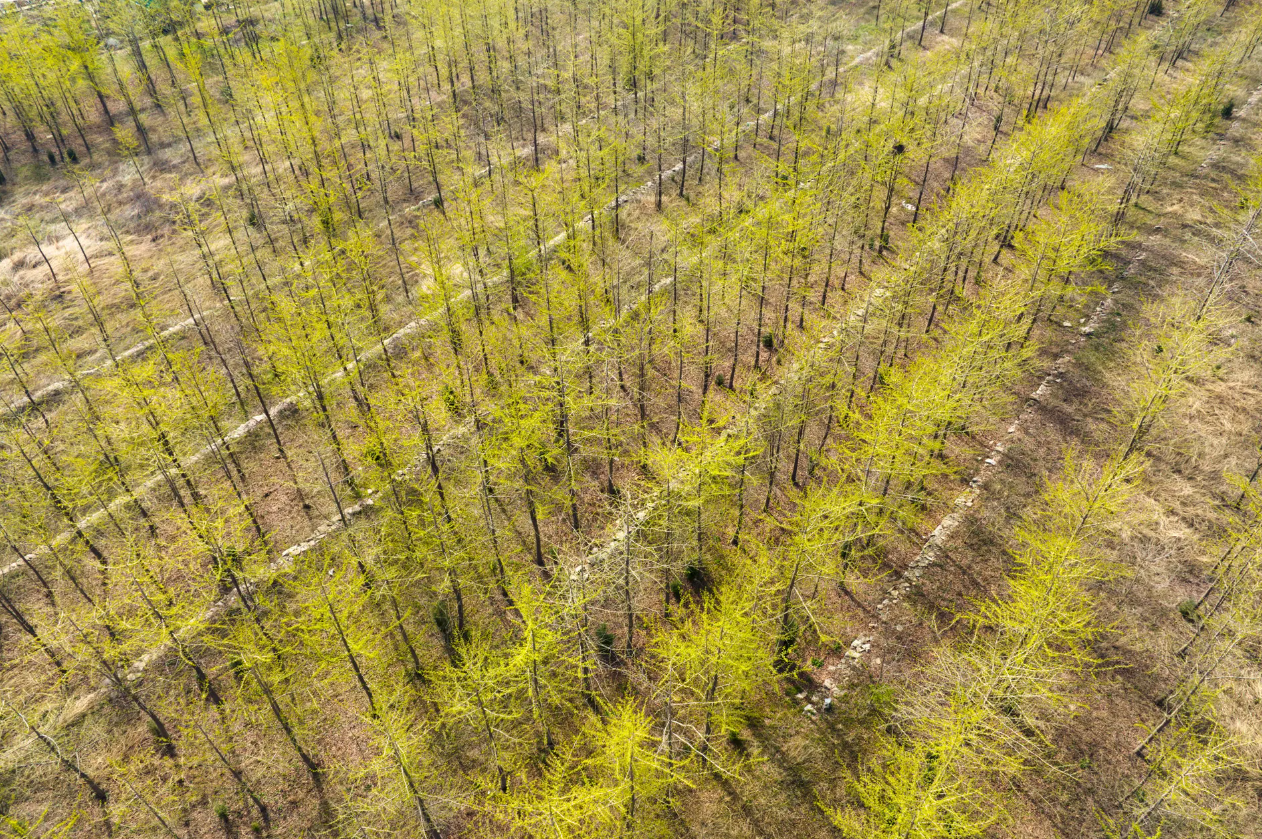
December 13, 2023

In a cavernous theater lit up with the green shapes of camels and palms at COP28 in Dubai, ecologist Thomas Crowther, former chief scientific adviser for the United Nations’ Trillion Trees Campaign, was doing something he never would have expected a few years ago: begging environmental ministers to stop planting so many trees.
Mass plantations are not the environmental solution they’re purported to be, Crowther argued when he took the floor on December 9 for one of the summit’s “Nature Day” events. The potential of newly created forests to draw down carbon is often overstated. They can be harmful to biodiversity. Above all, they are really damaging when used, as they often are, as avoidance offsets— “as an excuse to avoid cutting emissions,” Crowther said.
The popularity of planting new trees is a problem—at least partly—of Crowther’s own making. In 2019, his lab at ETH Zurich found that the Earth had room for an additional 1.2 trillion trees, which, the lab’s research suggested, could suck down as much as two-thirds of the carbon that humans have historically emitted into the atmosphere. “This highlights global tree restoration as our most effective climate change solution to date,” the study said. Crowther subsequently gave dozens of interviews to that effect.
This seemingly easy climate solution sparked a tree-planting craze by companies and leaders eager to burnish their green credentials without actually cutting their emissions, from Shell to Donald Trump. It also provoked a squall of criticism from scientists, who argued that the Crowther study had vastly overestimated the land suitable for forest restoration and the amount of carbon it could draw down. (The study authors later corrected the paper to say tree restoration was only “one of the most effective” solutions, and could suck down at most one-third of the atmospheric carbon, with large uncertainties.)
Crowther, who says his message was misinterpreted, put out a more nuanced paper last month, which shows that preserving existing forests can have a greater climate impact than planting trees. He then brought the results to COP28 to “kill greenwashing” of the kind that his previous study seemed to encourage—that is, using unreliable evidence on the benefits of planting trees as an excuse to keep on emitting carbon.
“Killing greenwashing doesn’t mean stop investing in nature,” he says. “It means doing it right. It means distributing wealth to the Indigenous populations and farmers and communities who are living with biodiversity.”
The question is, did countries at COP28 get the point? A few minutes after Crowther spoke, Mariam Almheiri, the climate change and environment minister for the host country, the United Arab Emirates, addressed the theater. She praised his presentation, then began boasting that the UAE was almost halfway to planting 100 million mangroves by 2030. At the same time, the UAE’s state oil firm, ADNOC (whose CEO was the president of COP28), has the biggest future expansion plans of any oil company in the world—an expansion incompatible with meeting the Paris Agreement’s targets, which sought to limit global warming to 1.5 degrees Celsius. That’s greenwashing, according to Kate Dooley, a researcher at the University of Melbourne who has studied nature restoration’s carbon drawdown. “Carbon storage in nature is temporary and therefore is not equivalent to permanent fossil fuel emissions,” Dooley says.
Walking along the shaded pathways of Dubai’s Expo City later that day, Crowther said he didn’t “know enough about the process to pass judgment” on the UAE’s plans, but was enthused to have heard other ministers talking about empowering Indigenous communities to protect and nurture woodland. “Five years ago, the conversation around nature was nothing like that,” he said.
This kind of optimism—with a tinge of naivete—is what has allowed the bearded and ponytailed Crowther, who enjoys playing a handpan drum and making “bushcraft” camps in the Zurich woods, to have made such an impact at only 37 years old. Growing up “obsessed with nature” in the Welsh countryside, he overcame struggles with dyslexia to get a PhD and a postdoc at Yale. It was there that a housemate working with what was then the UN’s Billion Tree Campaign raised a question that would launch Crowther’s meteoric rise in academia: How many trees are there in the world?
Few thought it could be answered, since satellites can’t see how many trunks there are beneath a forest canopy. But Crowther and a colleague started using artificial intelligence to find relationships between on-the-ground tree counts and satellite imagery of the same areas, and then extrapolated their findings across larger regions. Collecting and analyzing data from other scientists, they published a map of forest density in 2015 that suggested there were 3 trillion trees on Earth, far higher than previously thought. The UN’s tree-planting campaign was upgraded from a billion to a trillion trees. In 2017 Crowther received $2.7 million from a Dutch foundation to start his own lab.
Then came the 2019 study. Al Gore mentioned it to Salesforce CEO Marc Benioff, who started his own One Trillion Trees initiative with the World Economic Forum and convinced Trump to sign on. Crowther became one of the project’s advisers (thus becoming associated with two “trillion trees” campaigns). The popularity of the idea quickly spiraled—so much so that countries around the world have now made so many of their own tree-planting pledges that these would require at least 500 million hectares of land to fulfill, an area more than half the size of the United States. All this while global emissions have continued to increase.
The fallout over the 2019 study devastated Crowther, because it undermined confidence in nature restoration projects, when in fact countries and companies need to scale up investments in restoration as well as decarbonization, he says. The crisis of confidence in nature-based programs has continued this year, as another form of carbon offsetting—the purchase of private carbon credits to preserve existing forests—has been revealed as worthless in many cases. “There still are debates about whether nature has a role in climate,” Crowther says. “And this has been crippling to the environmental movement.”
In response, Crowther’s November study—with more than 200 scientists listed as coauthors—instead stresses the power of preserving intact woodlands. While restoring destroyed or fragmented forests would absorb a potential 87 gigatonnes of carbon, simply allowing existing forests to grow to maturity would absorb an additional 139 gigatonnes. These estimates exclude urban, farming, and grazing areas that may once have held forests but are unlikely to be given over to nature.
For reference, humans have emitted roughly 2,500 gigatonnes of carbon throughout history, which has largely ended up in the atmosphere and oceans. Forest restoration wouldn’t be a silver bullet to the climate crisis, but it could, theoretically, make a meaningful difference. And the paper showed that “clearly nature is a central part of our fight against climate change,” says Crowther of his new research. “But more importantly, it was sort of like the guideposts on what responsible commitments to nature must mean.”
The new paper has drawn far less criticism from other scientists. But it may still overestimate the carbon potential of forest restoration by including areas like drylands and “working forests” needed for sustainable logging, says Matthew Fagan of the University of Maryland, Baltimore County. These high-end estimates of forest potential could again encourage misinterpretation and greenwashing, he worries.
“That’s where I think it’s incumbent upon Dr. Crowther to clarify how fast this carbon can be gained, the limitations in their work, and the likelihood that the real number is probably going to be much lower. They mentioned that in their paper, but they need to flesh that out with numbers soon,” Fagan says.
And even if forests are restored and preserved the right way (by avoiding sapling die-offs, wildfires, or evictions of Indigenous people), such nature projects can still contribute to greenwashing if they’re used as an excuse by businesses or governments to continue emitting carbon as usual—especially if they end up being less effective at drawing down carbon than expected.
In a win for genuine nature restoration, the texts agreed at COP28 included for the first time a reference to the Glasgow Declaration goal of reversing forest loss by 2030, as well as the “need for enhanced support and investment” to reach that target. The summit also moved forward on establishing rules for countries’ “non-market” investments in nature—essentially grants rather than credits—while failing to agree on country-to-country emissions-counting deals or a UN market for carbon credits. That will raise further doubts that carbon offsetting is the wave of the future.
But greenwashing is tough to kill. Norway’s $50 million donation to the Amazon Fund at COP28 sounds impressive—until you consider that the country recently approved $18 billion in new oil and gas projects, including by state-owned Equinor. (It’s estimated that the world needs to spend an additional $700 billion per year to halt nature and biodiversity loss.)
“If no one had ever said, ‘Plant a trillion trees,’ I think we’d have been in a lot better space,” Crowther says. “But maybe there wouldn’t have been so much noise and attention on nature, so that all the very responsible scientists who are here could correct it and turn it into something that is good.”
Updated 12-13-2023 2:45 pm GMT: The final three paragraphs of this story were updated to reflect the finalization of the COP28 agreement.
Updated 1-4-2024 5:45 pm GMT: Matthew Fagan’s university affiliation was corrected.



